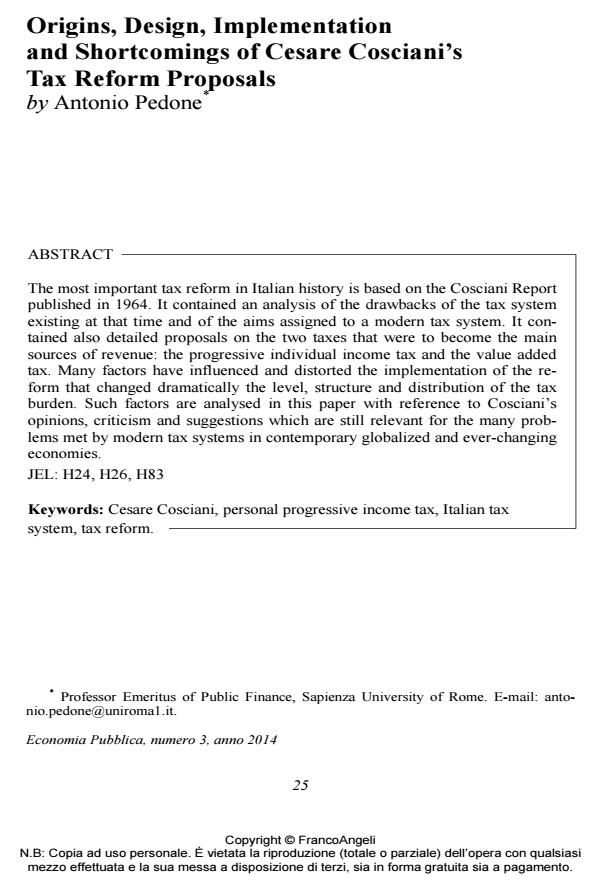Origins, Design, Implementation and Shortcomings of Cesare Cosciani’s Tax Reform Proposals
Journal title ECONOMIA PUBBLICA
Author/s Antonio Pedone
Publishing Year 2015 Issue 2014/3 Language English
Pages 14 P. 25-38 File size 168 KB
DOI 10.3280/EP2014-003002
DOI is like a bar code for intellectual property: to have more infomation
click here
Below, you can see the article first page
If you want to buy this article in PDF format, you can do it, following the instructions to buy download credits

FrancoAngeli is member of Publishers International Linking Association, Inc (PILA), a not-for-profit association which run the CrossRef service enabling links to and from online scholarly content.
The most important tax reform in Italian history is based on the Cosciani Report published in 1964. It contained an analysis of the drawbacks of the tax system existing at that time and of the aims assigned to a modern tax system. It contained also detailed proposals on the two taxes that were to become the main sources of revenue: the progressive individual income tax and the value added tax. Many factors have influenced and distorted the implementation of the reform that changed dramatically the level, structure and distribution of the tax burden. Such factors are analysed in this paper with reference to Cosciani’s opinions, criticism and suggestions which are still relevant for the many problems met by modern tax systems in contemporary globalized and ever-changing economies.
Keywords: Cesare Cosciani, personal progressive income tax, Italian tax system, tax reform.
Jel codes: H24, H26, H83
- Cosciani C. (1948). A Critical Examination of the Italian Tax system. Banca Nazionale del Lavoro Quarterly Review, I (5): 311-320.
- Cosciani C. (1950). La riforma tributaria. Firenze: La Nuova Italia.
- Cosciani C. (1963). The Aims of a Taxation Reform in Italy. Banca Nazionale del Lavoro Quarterly Review, 67, December: 347-365.
- Cosciani C. (1967). Tax Reform in Italy: Hopes and Misgivings. Banca Nazionale del Lavoro Quarterly Review, 82, September: 203-219.
- Cosciani C. (1971). Annotazioni concrete sulla riforma tributaria. Bancaria, XXVII, 5: 598-605.
- Cosciani C. (1976). Effetti dell’inflazione sul sistema tributario. Bancaria, XXXII, 8: 775-784.
- Cosciani C. (1983). Scritti scelti di finanza pubblica. Padova: Cedam.
- Cosciani C. (1984). I principi informatori della riforma tributaria nei lavori preparatori: validità e limiti nella situazione attuale. In: Gerelli E. e Valiani R. (a cura di), La crisi dell’imposizione progressiva sul reddito. Milano: Franco Angeli.
- CSRT (Commissione per lo studio della riforma tributaria) (1964). Stato dei lavori della Commissione per lo studio della riforma tributaria. Milano: Giuffrè. D’Albergo E. (1949). Orientamenti per una revisione del sistema tributario italiano. Bologna: Zuffi.
- Einaudi L. (1927). La guerra e il sistema tributario italiano. Bari: Laterza.
- Forte F. (2009). Ezio Vanoni economista pubblico. Soveria Mannelli: Rubbettino.
- Fuà G. e Rosini E. (1985). Troppe tasse sui redditi. Bari-Roma: Laterza.
- Hicks J. (1981). The Concept of Income in Relation to Taxation and to Business Management. In: Roskamp K. and Forte F. (eds.), Reforms of Tax Systems. Detroit: Wayne University: 73-85.
- Longobardi E. (1984). La politica fiscale. In: Ascoli U. (a cura di), Welfare State all’italiana. Bari: Laterza.
- Longobardi E. e Pedone A. (1994). La politica tributaria. In Pizzuti F.R., L’economia italiana dagli anni Settanta agli anni Novanta. Milano: McGraw-Hill: 487-504.
- Ministero per la Costituente (1946). Rapporto della Commissione economica, vol. V, Finanza, parte I (Relazione) e II (Appendice alla Relazione). Roma. Peacock A.T. and Wiseman J. (1961). The Growth of Public Expenditure in the United Kingdom. Princeton: Princeton University Press.
- Pedone A. (1968). Alcune considerazioni sul progetto di riforma tributaria. Rassegna Economica, XXXI, 6, novembre-dicembre 1967: 1331-1342; and XXXXII, n. 2, marzo-aprile 1968: 341-356.
- Pedone A. (1984). The 1973-74 Tax Reform in Italy: A Partial Success with Many
- Shortcomings. Banca Nazionale del Lavoro Quarterly Review, 151: 327-549.
- Pedone A. (1999). The Italian Tax System Between Two Reforms. Review of Economic Conditions In Italy, 1: 19-56.
- Pedone A. (2006). On some recurrent problems of Italian tax policy. Review of Economic Conditions in Italy, 3: 315-343.
- Pedone A. (2009). Tax Theory and Tax Practice: the Problems of Defining, Measuring and Assessing Tax Bases. In: Longobardi E. e Petretto A. (a cura di), Saggi di Economia della Tassazione. Milano: Franco Angeli: 17-38.
- Pedone A. (2010). L’evoluzione del sistema tributario italiano e il ruolo di Assonime. In: Pedone A. e Gallo F. (a cura di), Imposte e sviluppo economico. Roma-Bari: Laterza.
- Piketty T. (2013). Le capital au XXIe siècle. Paris: Éditions du Seuil.
- Ricotti G. e Sanelli A. (2006). Conti finanziari e fiscalità: un’analisi storica. In: Banca d’Italia, I conti finanziari: la storia, i metodi, l’Italia, i confronti internazionali. Roma: Banca d’Italia.
- Scoca S. (1945). Appunti per la riforma tributaria. Roma: SELI.
- Simons H.C. (1950). Federal Tax Reform. Chicago: The University of Chicago Press.
- Steve S. (1945). La riforma tributaria in Italia. Roma, Partito Liberale Italiano.
- Steve S. (1947). Il sistema tributario e le sue prospettive. Milano-Roma: Rizzoli;
- repr. in S. Steve (1997), Scritti scelti. Milano: FrancoAngeli: 133-267.
- Steve S. (1984). Conclusioni. In: Gerelli E. e Valiani R. (a cura di), La crisi dell’imposizione progressiva sul reddito. Milano: FrancoAngeli: 277-286.
- Tanzi V. (1986). Inflazione e imposta personale sul reddito: una prospettiva internazionale. Bologna: il Mulino.
Antonio Pedone, Origins, Design, Implementation and Shortcomings of Cesare Cosciani’s Tax Reform Proposals in "ECONOMIA PUBBLICA " 3/2014, pp 25-38, DOI: 10.3280/EP2014-003002